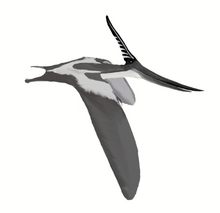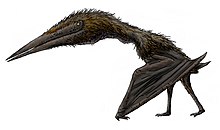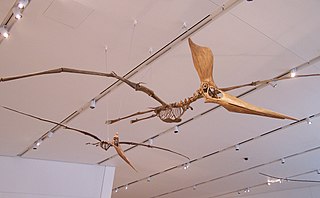
The Pteranodontidae are a family of large pterosaurs from the Late Cretaceous of North America and possibly other continents including Europe and Africa. The family was named in 1876 by Othniel Charles Marsh. Pteranodontids had a distinctive, elongated crest jutting from the rear of the head. The spectacularly-crested Nyctosaurus is sometimes included in this family, though usually placed in its own family, the Nyctosauridae.
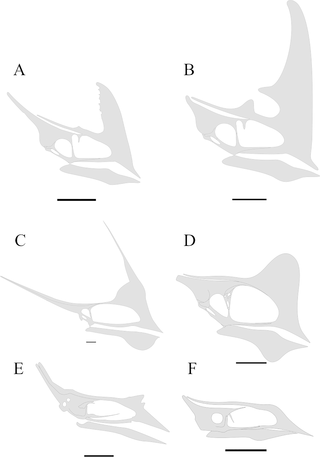
Tapejaridae are a family of pterodactyloid pterosaurs from the Cretaceous period. Members are currently known from Brazil, England, Hungary, Morocco, Spain, the United States, and China. The most primitive genera were found in China, indicating that the family has an Asian origin.
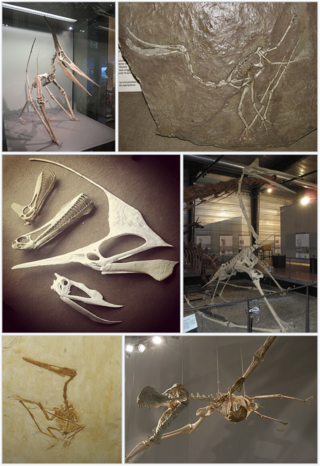
Pterodactyloidea is one of the two traditional suborders of pterosaurs, and contains the most derived members of this group of flying reptiles. They appeared during the middle Jurassic Period, and differ from the basal rhamphorhynchoids by their short tails and long wing metacarpals. The most advanced forms also lack teeth, and by the late Cretaceous, all known pterodactyloids were toothless. Many species had well-developed crests on the skull, a form of display taken to extremes in giant-crested forms like Nyctosaurus and Tupandactylus. Pterodactyloids were the last surviving pterosaurs when the order became extinct at the end of the Cretaceous Period, together with the non-avian dinosaurs and most marine reptiles.

Gallodactylidae is a group of pterosaurs within the suborder Pterodactyloidea. Gallodactylids differed from other related pterosaurs in several distinct features, including fewer than 50 teeth present only in the jaw tips, and rounded crests present on the rear portion of the skull and jaws but not near the ends of their snouts. At least some species possessed jaw flanges, possibly used to bissect hard-shelled prey.

Lonchodectidae or Lonchodraconidae is a group of pterosaurs within the clade Pterodactyloidea. It has variously been considered to be within Ctenochasmatoidea, Azhdarchoidea and Pteranodontoidea. They are notable for their high, conical tooth sockets and raised alveolar margins.

Ornithocheiroidea is a group of pterosaurs within the extinct suborder Pterodactyloidea. They were typically large pterosaurs that lived from the Early to Late Cretaceous periods, with fossil remains found all over the world except Antarctica.

Dsungaripteroidea is a group of pterosaurs within the suborder Pterodactyloidea.

Azhdarchoidea is a group of pterosaurs within the suborder Pterodactyloidea, more specifically within the group Ornithocheiroidea. Pterosaurs belonging to this group lived throughout the Early and Late Cretaceous periods, with one tentative member, Tendaguripterus, that lived in the Late Jurassic period. The largest azhdarchoids include members of the family Azhdarchidae, examples of these are Quetzalcoatlus, Hatzegopteryx, and Arambourgiania. Other notable pterosaur families belonging to the Azhdarchoidea are the Tapejaridae, the Thalassodromidae, and the Chaoyangopteridae. This group contains some of the most advanced members of the pterosaur order.
Elanodactylus is a genus of ctenochasmatid pterodactyloid pterosaur from the Early Cretaceous period of what is now the Yixian Formation of Liaoning, China.

Nyctosauridae is a family of specialized soaring pterosaurs of the late Cretaceous Period of North America, Africa, and possibly other continents including South America. It was named in 1889 by Henry Alleyne Nicholson and Richard Lydekker.

Pteranodontia is an extinct group of ornithocheiroid pterodactyloid pterosaurs. It lived during the Late Cretaceous of North America, South America, Europe and Africa. They were some of the most advanced pterosaurs, and possessed highly specialized cranial crests that may have served as sexual attraction, with males having a much larger crest.
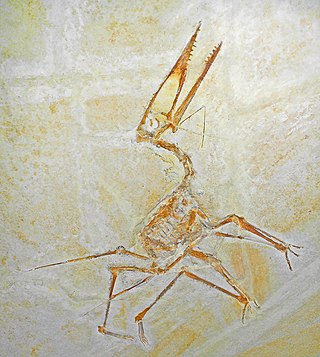
Germanodactylidae is a controversial group of pterosaurs within the suborder Pterodactyloidea. It was first named by Yang Zhongjian in 1964, and given a formal phylogenetic definition in 2014 by Brian Andres, James Clark, and Xu Xing. They defined it as the least inclusive clade containing Germanodactylus cristatus and Normannognathus wellnhoferi, which they considered to be close relatives at the time. However, more recent studies by the same researchers have found that these pterosaurs may be only distantly related.
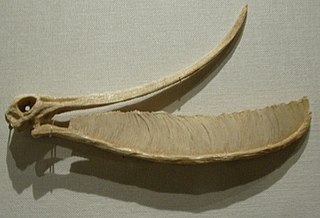
Archaeopterodactyloidea is an extinct clade of pterodactyloid pterosaurs that lived from the middle Late Jurassic to the latest Early Cretaceous periods of Africa, Asia, Europe and North America. It was named by Alexander Wilhelm Armin Kellner in 1996 as the group that contains Germanodactylus, Pterodactylus, the Ctenochasmatidae and the Gallodactylidae. In 2003, Kellner defined the clade as a node-based taxon consisting of the last common ancestor of Pterodactylus, Ctenochasma and Gallodactylus and all its descendants. Although phylogenetic analyses that based on David Unwin's 2003 analysis do not recover monophyletic Archaeopterodactyloidea, phylogenetic analyses that based on Kellner's analyses, or the analyses of Brian Andres recover monophyletic Archaeopterodactyloidea at the base of the Pterodactyloidea.

Pteranodontoidea is an extinct clade of ornithocheiroid pterosaurs from the Early to Late Cretaceous of Asia, Africa, Europe, North America and South America. It was named by Alexander Wilhelm Armin Kellner in 1996. In 2003, Kellner defined the clade as a node-based taxon consisting of the last common ancestor of Anhanguera, Pteranodon and all its descendants. The clade Ornithocheiroidea is sometimes considered to be the senior synonym of Pteranodontoidea, however it depends on its definition. Brian Andres in his analyses, converts Ornithocheiroidea using the definition of Kellner (2003) to avoid this synonymy.

Ornithocheirae is an extinct clade of pteranodontoid pterosaurs from the Early Cretaceous to the Late Cretaceous of Asia, Europe, North America and South America. It was named by Harry Seeley in 1870 as a family that contains Ornithocheirus and its relatives. The name was emended to Ornithocheiridae, to match the requirements of the ICZN Code that a family-ranked clade should end with an -idae suffix. Brian Andres (2010) in his review of pterosaur phylogeny, defined the name Ornithocheirae phylogenetically, as a node-based taxon consisting of the last common ancestor of Anhanguera and Ornithocheirus and all its descendants. Thus Ornithocheirae is defined to include two families, the Anhangueridae and the Ornithocheiridae, following the opinion of Alexander Kellner and Andres that these families should not be synonymized based on their original phylogenetical definitions. However, subsequent studies in 2019 have found Ornithocheirae to be a more inclusive group containing both Anhangueria and Targaryendraconia.

Anhangueria is a group of pterosaurs belonging to the clade Pteranodontoidea. Fossil remains of this group date back from the Early to Late Cretaceous periods, around 140 to 92.5 million years ago. Anhangueria was named by paleontologists Taissa Rodrigues and Alexander Kellner in a review of Ornithocheirus species in 2013, they defined the clade as a branch-based taxon consisting of all pteranodontoids more closely related to Anhanguera blittersdorffi than to Istiodactylus latidens and Cimoliopterus cuvieri.
Alamodactylus is an extinct genus of pteranodontian pterosaur known from the Late Cretaceous of Texas, southern United States. It contains a single species, Alamodactylus byrdi.

Kryptodrakon is an extinct genus of pterodactyloid pterosaur from the Middle to Late Jurassic with an age of approximately 162.7 million years. It is known from a single type species, Kryptodrakon progenitor. The age of its fossil remains made Kryptodrakon the basalmost and oldest pterodactyloid known to date.

Tethydraco is a genus of pterodactyloid pterosaur that lived during the Late Cretaceous period of what is now the area of present Morocco, about 66 million years ago. Tethydraco was originally assigned to the family Pteranodontidae. Some researchers argued that subsequently described material suggests that it may have been an azhdarchid, and possibly synonymous with Phosphatodraco, though this has been disputed. The type and only species is T. regalis.

Barbaridactylus is a nyctosaurid pterosaur from the Ouled Abdoun Basin of Morocco, a basin that dates back to the Maastrichtian stage of the Late Cretaceous. It was published in 2018 by paleontologists Nicholas R. Longrich, David M. Martill, and Brian Andres. In the same publication, two other pterosaurs from the same basin were described: Alcione and Simurghia. The type and only species is B. grandis.
